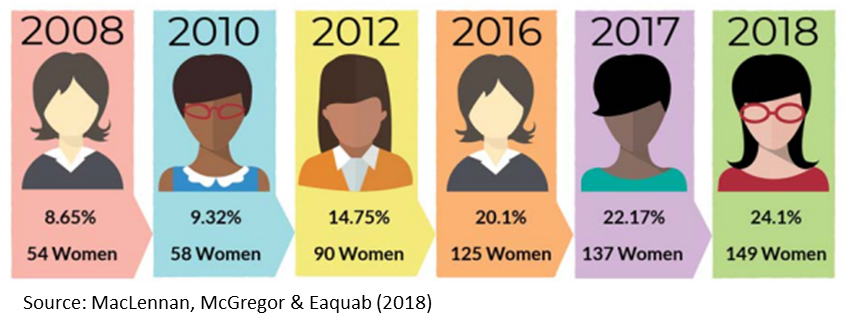
Today's Top 5 is a guest post from Mary Jo Vergara, economist at Kiwibank.
As always, we welcome your additions in the comments below or via email to david.chaston@interest.co.nz.
And if you're interested in contributing the occasional Top 10 yourself, contact gareth.vaughan@interest.co.nz.
Women’s economic status in New Zealand has improved since the days of the Hippie (see my previous Top 5). Bell-bottoms, disco balls and Chuck Norris are out. But some things are still in fashion, and are slowing progress. Here are five ways we can keep the momentum going.
1) Change how certain occupations are perceived.

More work needs to be done to break up the clustering of men and women in certain occupations. And the best place to start is in the classroom. The same pigeonholing of students seen in the 70s is still evident today. Women are outnumbered four to one in the engineering workshops, and three to one in the computer labs. With the rise of robots upon us, there’s strong impetus for women to deepen their footprint in STEM subjects.
In fact, the Ministry of Business, Innovation and Employment lists civil engineers, science technicians and software developers as among the most in-demand jobs. Jobs traditionally held by men. A similar story can be told of boys. Male representation in education, health (excluding medicine) and the arts has been lacking for decades. Shortland Street Hospital may only exist on our television screens, but it echoes real life for male nurses.
So organise a careers day at your children’s school. And bring in industry representatives of the opposite gender. Better still, both genders. Take President and COO of SpaceX, Gwynne Shotwell, for example. Shotwell’s path to becoming one of the world’s most successful engineers began with hearing from a female mechanical engineer – “She was doing really critical work, and I loved her suit. And that’s what a 15-year-old girl connects with”.
2) Establish targeted scholarships, not targeted quotas. A bottom-up solution for a top-level problem.


One way to fast-track achieving gender equality, particularly at the leadership level, is through gender quotas. However, many – including women – recoil at the idea of implementing quotas. Because stigma is a parasite to the system. A helping hand may regard women as being less qualified and could undermine the legitimacy of their rise through the ranks. Women want to be recognised for their skills and capabilities. And it is their ability to add value that earns them a seat at the boardroom. Not because they have one extra X chromosome.
Efforts are better directed toward ushering more women into the boardroom, rather than closing the door on those deserving of a seat. To solve the top-level problem, a bottom-up approach is best. Bottom-up meaning education (again). Targeted scholarships could provide incentive for girls to sit in classrooms they would otherwise walk past.
The Reserve Bank of New Zealand, for example, offers the Women in Central Banking Scholarship. Females are encouraged into post-graduate study in areas including economics, finance and maths. And a guaranteed position at the bank gets their feet firmly in the door. Scholarships offered at the post-graduate level would certainly help women become leadership-ready. Indeed, the correlation between the rise of women in top positions and the rise of women in higher education is of no coincidence. Scholarships may not be the speedy solution that affirmative action, like quotas, offers. But education can be a pretty powerful tool to smash the glass ceiling.
3) Make parental leave more flexible. Introduce paternal leave.

The Parental Leave and Employment Protection Act 1987 was enacted to support the changing roles of men and women within and beyond the home. But it’s clear that women still shoulder majority of family responsibilities. To achieve a more equitable labour force, we need to adopt a more equitable approach to parenthood. While current legislation reflects this in principle, it’s falling short in execution. And it comes down to (poor) design. All paid parental leave is allocated to the primary carer, and women are named by default. Parental leave and maternity leave are effectively one and the same. Unless mothers transfer their leave, fathers are left with just two weeks unpaid leave. So even if men wanted to assume a greater role in the home, the apron just doesn’t come in their size.
Parental leave needs to be more flexible and shared across genders. Introducing paid paternity leave can help to achieve a more level playing field at home and at work. Perhaps we should take our cues from the Finns. Finland is the happiest country in the world, and their generous paternity leave is giving them a reason to smile. Leave reserved for fathers was raised so that they’re just as likely to be the primary carer. For both parents, there’s now equal opportunity to return to work and advance their careers.
4) Set-up childcare facilities in the workplace. 
The traditional family support network is weakening. But childcare is a critical factor in eliminating barriers to women’s full employment. There is thus a need to improve non-family childcare. And it is a need that can be met at the industry level.
For care of young children, an on-site crèche is a popular workplace solution. Employees would appreciate having their children just an elevator ride away. And given that it’s on-site, there’s no need to race out the door to meet the 6pm pickup time. Similarly, companies could set-up a “homework centre” where children can wait before- and after-school.
Obviously, some companies cannot practically have a crèche or centre on-site. These companies could instead team up with childcare providers to negotiate discounts, just as they do with healthcare providers. School holidays can be another source of worry for parents. Most employees are given four weeks of annual leave, but school holidays total 12 weeks. To help make up the difference, companies could also organise school holiday programmes and run camps.
To have facilities readily available is especially helpful when regular arrangements fall through. It can make the difference between an employee being absent or at work. In fact, along with lowered absenteeism, the International Labour Office also note improved productivity, high employee retention and reduced turnover as potential employer benefits.
But the best thing is, either parent can take up the offer. Better childcare can help both parents ensure the continuity of their careers despite having a young family.
5) Overhaul of the New Zealand tax system.

For many, the income tax is not the only payment made on each dollar earned. There are other ways one’s pocket can feel lighter on pay day. Families receiving government support such as Working for Families (WFF) are most affected. Because WFF payments are not universal, but taper out as household income rises above a threshold ($42,700 p.a.). So, the one to really worry about is the effective marginal tax rate (EMTR).
To best explain, consider the following scenario: A sole parent receives a pay rise that pushes them into the 30% income tax bracket. However, they might prefer a pat on the back over the new cheque. Because after income tax (30%) and ACC levies (1.21%) are paid, WFF payments abated (25%), student loan repayments made (12%), and Kiwisaver contributions withdrawn (3%), the parent could lose more than 70% (EMTR) of their new earnings.
For a two-parent household, the prospect of a high EMTR is particularly limiting for the secondary earner. For a number of reasons, namely childcare and occupation, the secondary earner has traditionally been women. But the family nucleus is evolving. And the playground bullies – welfare and tax policy – are picking on either parent.
So, to provide incentive for the secondary earner (women) to add more money to the jar, the abatement rate could be lowered. However, women’s experience with the tax system, as the secondary earners, may justify a complete overhaul. There’s merit in reviving the low flat-tax broad-based system of the 1980s. But this time, accompanied by a more considered user-pays scheme. The 90s tried this by aggregating all social assistance and applying a single abatement rate. But it failed terribly. And we’re still feeling the effects. Maybe it’s our turn to get it right.

It is not lost on me that there is a cost to each of the ‘solutions’ above: careers day events and scholarships require funding; extending paternity leave cost the Finnish government a tidy sum; establishing workplace childcare may eat into company profits; and a restructure of the current tax transfer interface will likely cause a few headaches. But does the need to ensure women are participating in the economy as much as they desire, justify the expense? I think so. It’s time to clean out the closet.
20 Comments
Let's face it, the way women are treated is rooted deep in our culture which is very much based in religious teachings and beliefs. Other religions are worse than the one on which our society is based.
This cultural base needs to be challenged big time. Churches still hold a lot of power across societies. People need to put the one gift that God gave everyone to proper use - their brain! Think dammit! Realise that religion is not about God, it is about power and control of the masses. It started in earnest about 1500 - 2000 years ago. Mindless adherence to religious teachings should be considered a blasphemy, just as mindless adherence to political ideology undermines democracy. Woman are just as capable as men and anyone who thinks otherwise is just an idiot!
Thinking about my wife's family in tribal Melanesia - a very clever family but if I asked her siblings they would challenge Murray's last sentence. To them clearly a man is stronger and better suited to heavy work, hunting and fishing but women are better suited to having children and caring work. It was only the arrival of Christianity about 150 years ago that gave women some status - now on occasion they own land and on request are permitted to speak at village gatherings.
If all that matters in this world is what can be studied at university then women are not only as capable but with 3 girls for every 2 boys going to uni maybe a margin better.
I commend any woman wishing to, and able to, make a career choice. However, the greatest momentum to women's professional participation is absolute financial necessity. That is, she either works or she and/or her partner and/or family fall into poverty. Neither the metrics nor the enthusiasm of this commentary touch on this issue. Financial panic is never a good primary driver in any choice.
Changing how occupations are perceived is probably more important to a child's parents than to the child. We still have a kiwi 'macho' culture comprising of beer and rugby that is supported and promoted by many many outlets in both the public and private sector. It could be argued that our 'national identity' is in conflict with itself, and I don't think I buy into the argument that it's about changing children's ideas of gender roles, but rather that a parent's idea of what their child should/could grow up to be needs challenging.
There's a thesis for someone bright - I gave up on arguing for arguments sake in the form of tertiary papers after I got my Bugger All degree.
My thoughts.
1. I think perception is changing, but it needs to work both ways. The perception of women in the workforce is definitely changing. Female graduates make up more than half of the Lawyers, Accountants, and Doctors today. STEM is also seeing a change. But we also need to see the perception in non-male areas change. Dads should not be viewed negatively at School, playgrounds, and family/parent areas.
2. I don't think this is required. Females are now dominating university enrollments, and the trend is starting to been seen elsewhere in the tertiary sector.
3. Agree - it should be equal.
4. I don't think this is the right way to approach it. It would be better for a parent to not have to work (i.e. salaries are high enough to facilitate a single earner)
5. Household/family tax rates, rather than individuals. I can have joint bank/trading/utilitity/property title accounts, joint expenses, earn Joint interest on my savings, joint dividends in my shares, WFF is based on joint income (if living together). Yet my tax rate is individual. A family is a homogeneous entity so why can't it be treated as one for tax purposes. It could well free up one individual to earn more so that the other can work less and focus on family more.
Helen Clark's piss-poor effort at Social Engineering with Working for Families was always going to end badly, and it will .
There should never be a need for middle -class welfare .
Quite frankly it costs the same , in terms of basics , to house , clothe and feed a child in Remuera as it does across SH1 in Onehunga .
So everyone should get a child rebate for each child they have , or simply have lower taxes .
And its simple to do , just a few more tax tables
5) Effective marginal tax rates are a nightmare. They send really poor signals (and end in perverse incentives to my mind) to a large swathe of NZ society. The NZ tax system seems too-broke-to-fix, judging on the number of TWGs we've had in the past couple of decades that seemed to get absolutely no where with their recommendations..
Nice article. Can i add however that under 35s everywhere in the western world women out earn their male counterparts. A phenomenon known as the man drought has occurred, educated or professional women not wanting to date or marry truckies or retail workers.
The fact that most board members are older males does scew things. That doesn't mean attempting to get more representation isn't a worthy notion.
My concern is male suicide rates are exploding, male depression rates are exploding. And as society becomes less racist and less sexiest it would appear neo classism is rising to the top. A generation of low income men with no house or well paid profession. No partner or kids. An education system and health system almost hostile to them. And a woke media unable to apply critical thinking and acknowledge that all people struggling in society need to be considered.
Not a week goes by without an article about women being unrepresented in aspects of society. Yes very true on many levels but also ignoring males and their struggles are worth some time.
If men out earn women then the man drought is a myth?
The cynic in me says this is more about power than equality - which pretty much already exists. You rarely see granular analysis like 82%+ primary school teachers are female, a profession which generally pays less than male dominated professions such as the trades. Dangerous, unpleasant jobs should pay more and you will find men tend to do these. So maybe there should be a structural gender pay gap?
Maori are only just ahead of females in median weekly income, and well behind the male/female average, I'll be waiting a while for that article though (no disrespect to the female readers either, you should absolutely get paid the same as a male for the same work and performance) https://www.stats.govt.nz/information-releases/labour-market-statistics…
Here's an anecdote, my daughter had to write an essay on the gender pay-gap recently (girls school). I pointed her to some stats around work-place deaths etc so she could take a Socratic and balanced approach. She said she couldn't argue from the male perspective as she would be marked down.
I agree Te Kooti
People doing the same work should get paid the same in the same company etc.
I personally think we need more female laborers and road workers, truckies etc.
I know hardcore feminists who are lawyers and vote green and labour and they all want to marry misogynist old male partners in law firms. It seems people preaching equality still desire societies alpha male.
Hypergamy it seems is genetic yet the patriachy is a social construct. Lets encourage cross collar relationships and take away the stigma.
Those penalized by marginal tax rates are far, far wider than the subset you've chosen to pick on. WFF abatements in particular penalize the two-partner family when one partner re-enters the workforce. A flat rate of child allowance (or a flat rate tax rebate per child) would solve all that, as opposed to the income derived (and abated) WFF.

We welcome your comments below. If you are not already registered, please register to comment.
Remember we welcome robust, respectful and insightful debate. We don't welcome abusive or defamatory comments and will de-register those repeatedly making such comments. Our current comment policy is here.